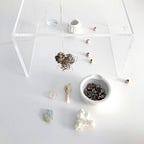Homage to a Lake
At the conclusion of my four years living along the shore of Connecticut’s deepest natural lake, Lake Wononscopomuc, it is striking how accustomed I have become to the proximity of a body of water and the atmospheric states that are perpetually unfolding.
The shoreline and protruding rocks along Wononscopomuc’s edge have served as markers during my daily outings as well as anchor points for the objects that I have floated over the lake’s body or tethered to its sides.
The idea for raft-like bundles came from reading about fossilized crinoid host colonies that historically traveled great distances over open waters, possibly across entire oceans, as driftwood rafts during the Jurassic period. The pandemic lockdown became an opportunity for me to imagine how one might travel such distances, at least when restricted to a specific region or shore. My lake became an ocean of sorts, and my ad-hoc floating vessels, the crafted expression of a longing to journey further.
‘Wononskopumuc’ is a Mahican name for ‘rocks at the bend in the lake.’ (1) The original Mahican homeland extended from the Hudson River Valley and Catskill Mountains in the north to the southern end of Lake Champlain. Bounded by the Schoharie River in the west, it extended east to the crest of the Berkshire Mountains in western Massachusetts from northwest Connecticut north to the Green Mountains in southern Vermont. (2)
As an homage to communities who have revered lakes as water ways and conduits for safe passage, my floating vessels and their documentation reference these forgotten narratives, and prompt us to perhaps imagine greater connectivity, passage beyond borders, and transport as hosts.
Stay tuned for my next chapter as I transition to a new studio with open fields, tilled farm plots, and restored interior spaces that float.
- Huden, John Charles; Museum of the American Indian, Heye Foundation (1962). Indian place names of New England. Smithsonian Libraries. New York : Museum of the American Indian, Heye Foundation.
- Mahican location, http://www.dickshovel.com/Mahican.html.
